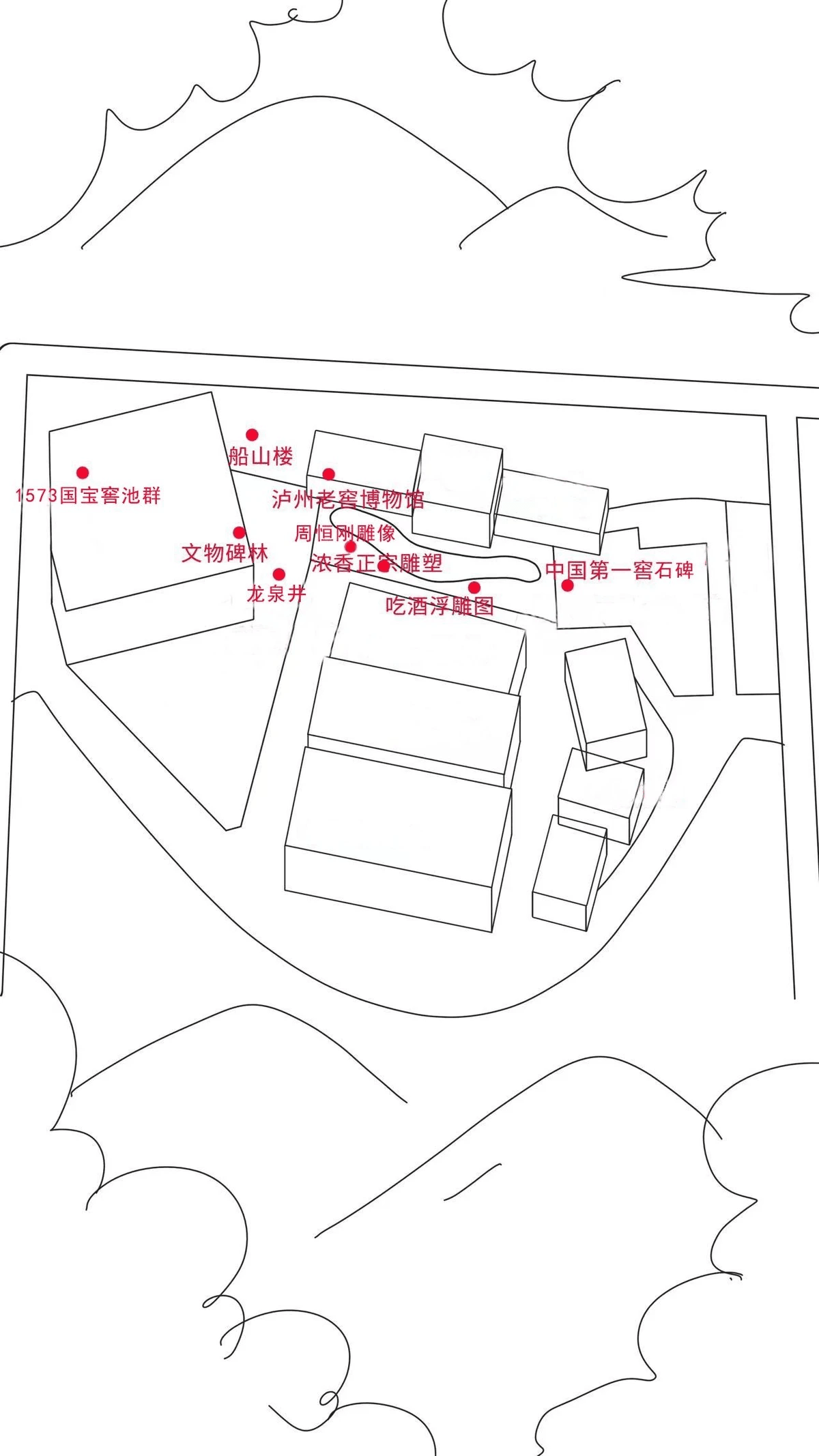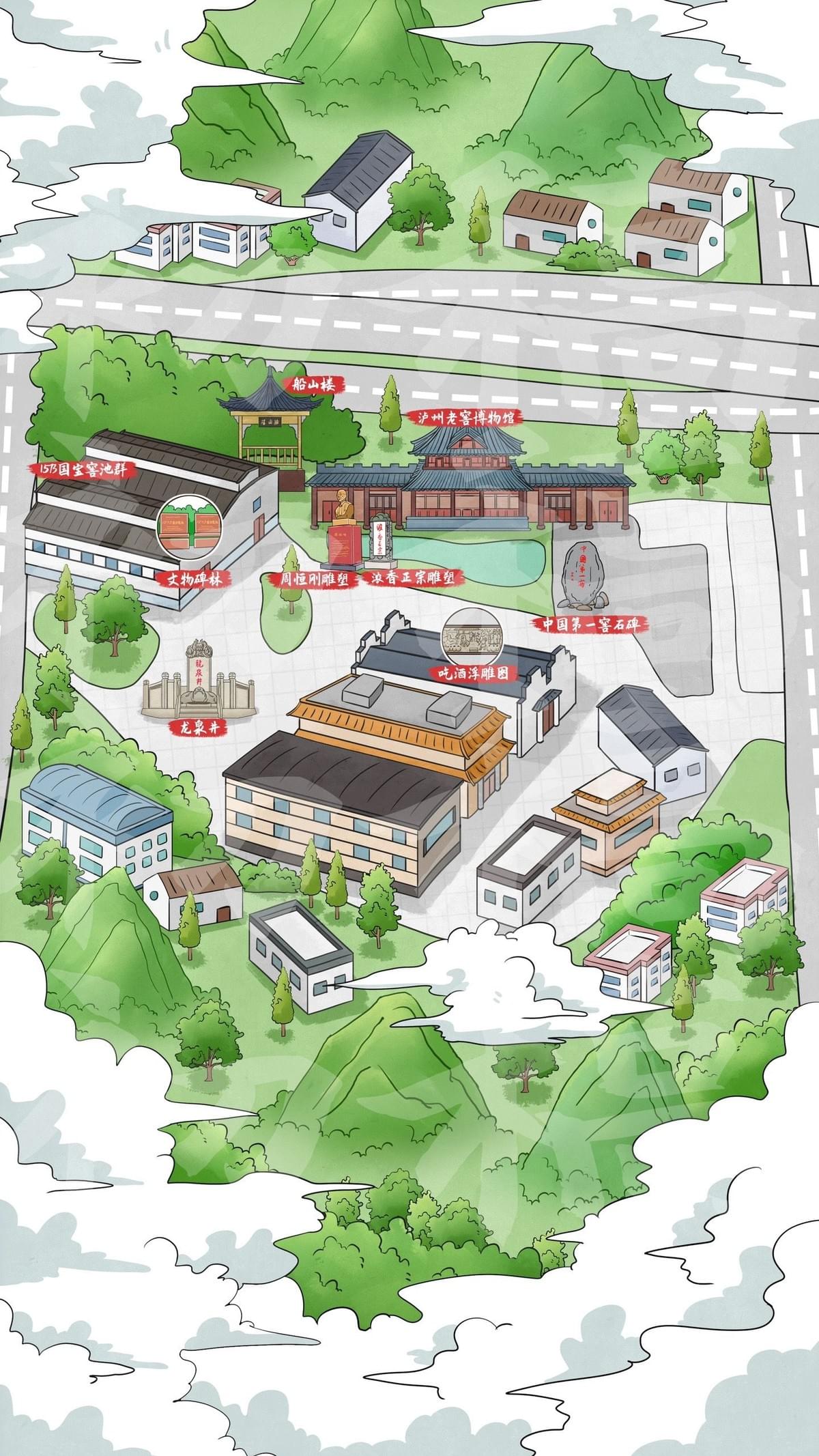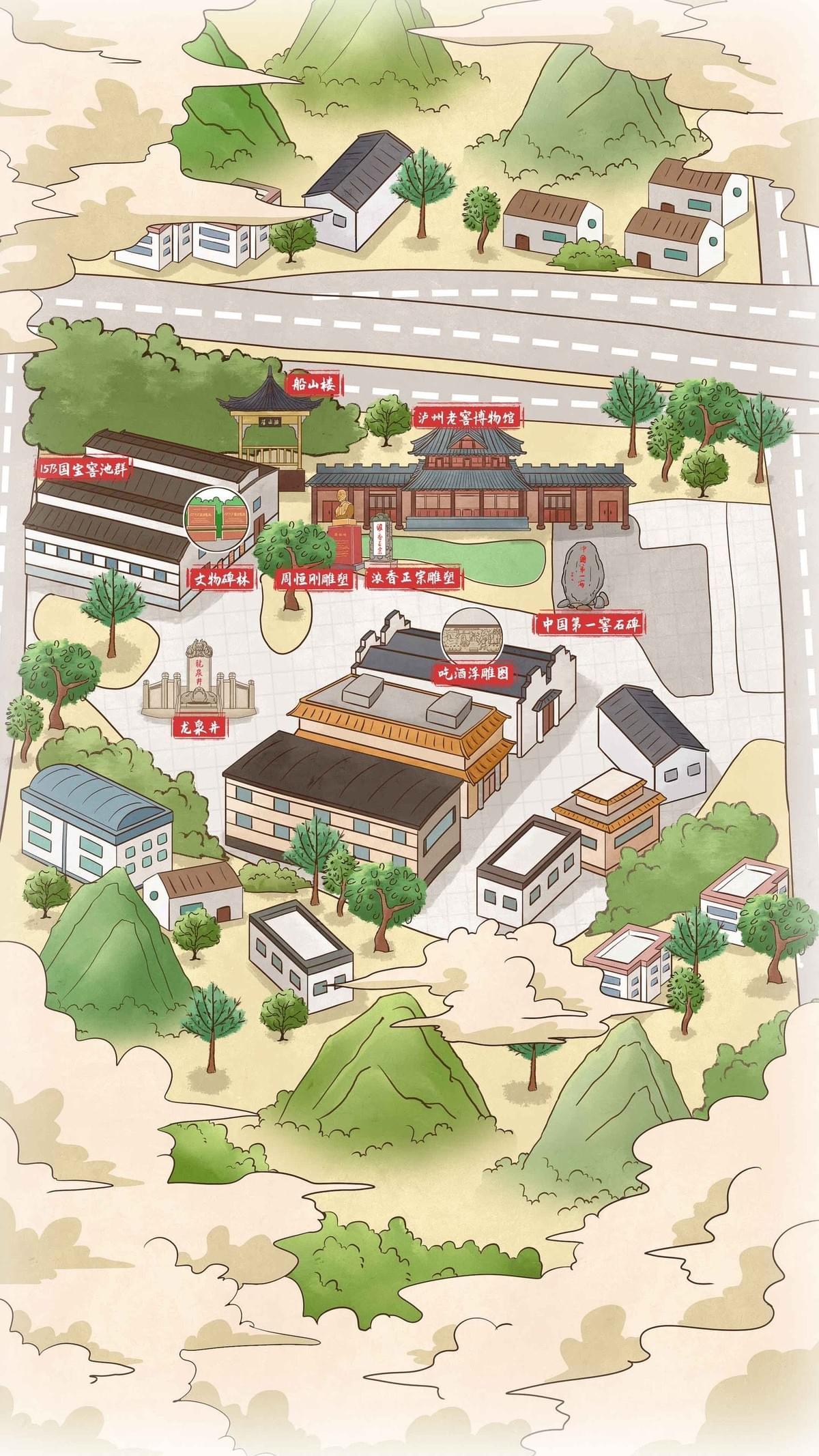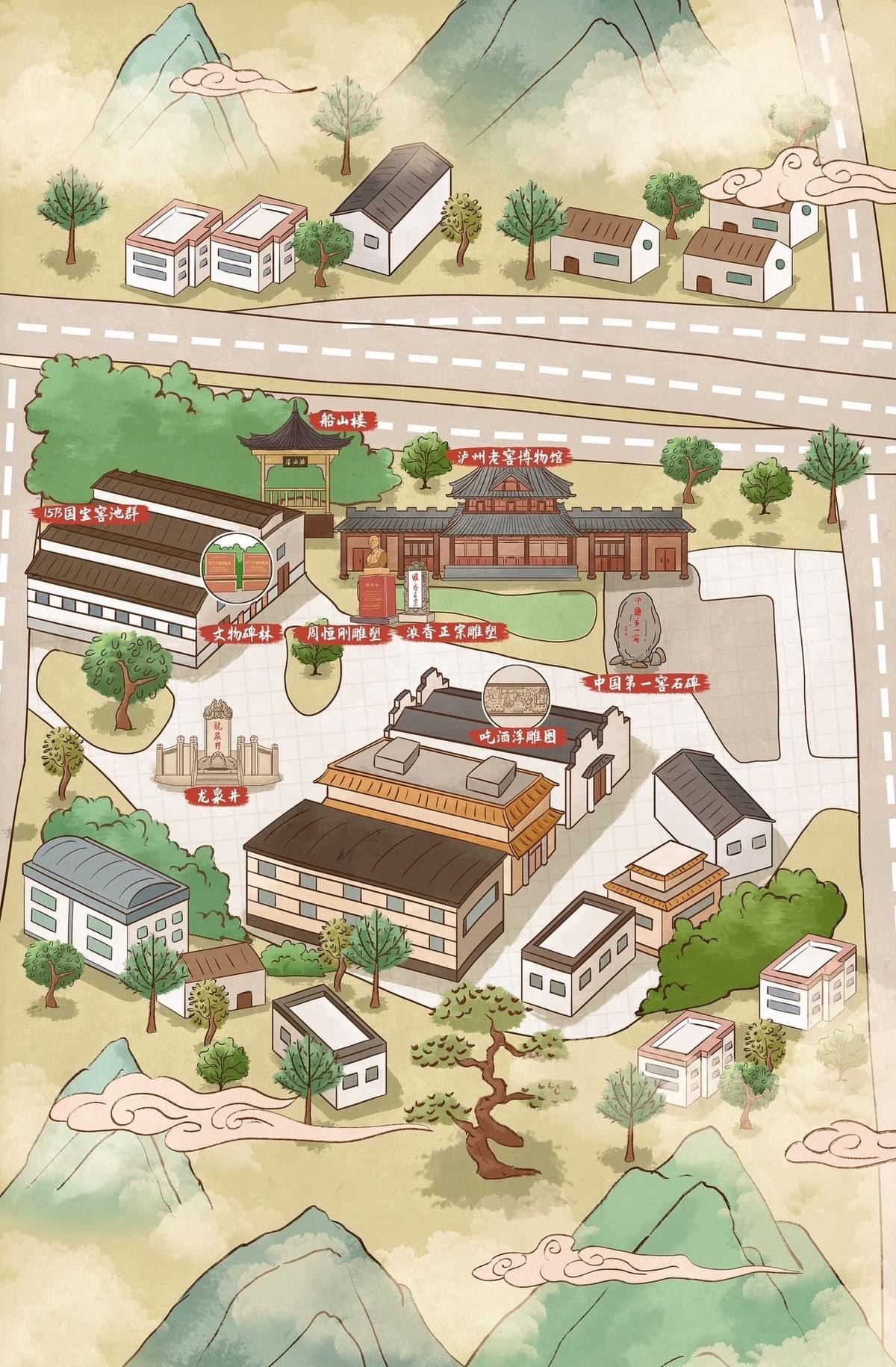Introduction
In the world of cartographic art, some projects transcend simple navigation to become cultural artifacts in their own right. The illustrated map of Luzhou Laojiao Distillery—China's oldest continuously operating baijiu distillery—represents precisely such an achievement. This remarkable fusion of artistic expression and functional design captures not just the physical layout of a historic landmark, but the essence of a 400-year legacy that has shaped Chinese spirits production since the Ming Dynasty. Join us as we explore the fascinating creative journey behind this unique illustrated map and discover how mapful.art transformed centuries of history into a visual masterpiece.
The Historical Significance of Luzhou Laojiao
Before diving into the creation process, it's essential to understand the extraordinary cultural significance of the subject itself. Founded in 1573 during the Ming Dynasty, Luzhou Laojiao isn't just another distillery—it's a living museum of traditional Chinese spirits production.
Home to the prestigious "Guojiao 1573" baijiu brand, the distillery harbors ancient fermentation pits, some over 200 years old, that continue to produce one of China's most celebrated spirits. These pits represent the heart of Luzhou-style baijiu production, a method that has remained largely unchanged for centuries, creating a unique connection between past and present.
The architectural complex itself blends historical structures with modern facilities, all nestled within the distinctive landscape of Sichuan province. This combination of living heritage, architectural significance, and cultural importance presented both a challenge and an opportunity for the mapful.art team.
The Research Process
The journey to create this illustrated map began with exhaustive research. The mapful.art team immersed themselves in the history and significance of Luzhou Laojiao, gathering information from multiple sources:
- Historical documents detailing the distillery's evolution since the 16th century
- Architectural plans and site layouts of the current facility
- Photographs documenting both historical and contemporary aspects
- Interviews with distillery experts about production methods and significant locations
- Cultural context about baijiu production and its importance in Chinese heritage
This research phase was crucial not only for accuracy but for understanding the emotional and cultural significance of each element to be included. The team needed to grasp which buildings held special historical importance, how the production process flowed through the facility, and which visual elements would resonate with both the client and visitors.
Artistic Vision and Design Approach
With research complete, the mapful.art team developed a distinctive artistic approach that would honor the distillery's heritage while creating a functional map. They crafted a visual style that beautifully blends:
Traditional Chinese Aesthetic Elements
- Stylized mountains and decorative clouds frame the composition, evoking traditional Chinese landscape painting
- A carefully selected color palette featuring earthy reds, soft greens, and muted yellows reflects classical Chinese artistic traditions
- Elegant architectural renderings honor the historical structures while maintaining visual clarity
- Decorative elements that complement rather than overwhelm the functional aspects of the map
Modern Mapping Functionality
- Clear identification of key buildings and points of interest using distinctive red banners with Chinese text
- Logical spatial organization showing relationships between different facilities
- An intuitive road network contextualizing the distillery's layout
- A carefully balanced overhead perspective that provides clarity while maintaining artistic integrity
This harmonious blend of traditional aesthetics and modern cartographic principles created a unified visual language that permeates every aspect of the finished map.
Technical Execution and Challenges
Bringing this vision to life required sophisticated technical execution. The mapful.art team employed a multi-stage process:
- Initial concept sketches based on site plans and photographs established the basic composition and perspective
- Digital rendering allowed for precise architectural details while maintaining artistic flourishes
- Texture and shading techniques created depth and visual interest across the map's surface
- Careful placement of text elements ensured information clarity without disrupting the aesthetic flow
- Integration of environmental elements like trees, decorative clouds, and landscape features to frame the composition
Throughout this process, the team faced several technical challenges:
- Balancing accurate scale with artistic expression
- Ensuring readability while maintaining aesthetic integrity
- Representing three-dimensional structures in a visually appealing yet understandable way
- Incorporating Chinese text elements that harmonized with the overall design
Key Features of the Illustrated Map
The finished map prominently highlights several crucial aspects of the Luzhou Laojiao Distillery:
The Central Distillery Complex
At the heart of the illustration sits the core historical buildings where the famous baijiu is produced. These structures are rendered with careful attention to architectural details that speak to their Ming Dynasty origins.
Cultural Heritage Sites
The map clearly identifies specific buildings of historical significance, including areas housing the ancient fermentation pits—the spiritual center of the distillery's traditional production methods.
Visitor Facilities
Recognizing the distillery's role as a cultural tourism destination, the map includes areas designated for visitors, educational exhibits, and tasting facilities.
Supporting Infrastructure
Administrative buildings and modern additions are integrated seamlessly into the historical complex, showing how the distillery continues to evolve while honoring its heritage.
Natural Surroundings
The landscape elements surrounding the distillery—mountains, vegetation, and waterways—provide context and highlight the natural environment that contributes to the spirit's unique terroir.
Transportation Access
A network of roads connecting the distillery to the wider region ensures the map serves practical navigation purposes for visitors.
The Map's Multiple Functions
The final illustrated map delivers exceptional value to Luzhou Laojiao Distillery by serving multiple purposes:
Tourism Enhancement
Visitors can navigate the historic site with ease while appreciating its beauty and significance through the artistic rendering.
Brand Storytelling
The map visually reinforces the brand's heritage and authentic production methods, becoming a powerful tool in communicating the Luzhou Laojiao story.
Educational Tool
The clear identification of different production areas helps visitors understand the traditional baijiu-making process and the significance of various locations.
Marketing Asset
The distinctive visual style creates a memorable image that can be utilized across promotional materials, from brochures and websites to packaging and advertisements.
Cultural Preservation
By documenting the historic site's layout and key features in an artistic format, the map contributes to preserving knowledge about this important cultural heritage site.
Conclusion
The illustrated map of Luzhou Laojiao Distillery represents a remarkable achievement in the intersection of art, culture, and functionality. The mapful.art team has created more than just a navigation tool—they've crafted a visual celebration of a 400-year legacy that continues to shape Chinese spirits production today.
Through meticulous research, thoughtful artistic choices, and technical excellence, this map honors the distillery's ancient heritage while serving thoroughly modern purposes. It stands as a testament to how cartographic art can transcend simple wayfinding to become a meaningful cultural artifact in its own right—one that tells the story of place, time, and tradition through the universal language of visual art.
For visitors who explore Luzhou Laojiao with this map in hand, the experience is enriched by understanding the context and significance of each building and production area they encounter. For the distillery itself, the map represents a beautiful fusion of their past, present, and future—a fitting tribute to China's oldest continuously operating baijiu producer.



